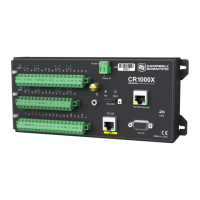16. Click Finish and give the program a meaningful name such as a site identifier. Click Save.
17. If LoggerNet or other data logger support software is running on your computer, and the
data logger is connected to the computer (see Making the software connection (p. 23) for
more information), you can choose to send the program. Generally it is best to collect data
first; so, we recommend sending the program using the instructions in Sending a program
to the data logger (p. 26).
NOTE:
A good practice is to always retrieve data from the data logger before sending a program;
otherwise, data may be lost. See Collecting data (p. 29) for detailed instruction.
If your data acquisition requirements are simple, you can probably create and maintain a data
logger program exclusively with ShortCut. If your data acquisition needs are more complex, the
files that ShortCut creates are a great source for programming code to start a new program or
add to an existing custom program using CRBasic. See the CRBasic Editor help for detailed
information on program structure, syntax, and each instruction available to the data logger.
NOTE:
Once a Short Cut generated program has been edited with CRBasic Editor, it can no longer
be modified with ShortCut.
3.5 Sending a program to the data logger
TIP:
It is good practice to always retrieve data from the data logger before sending a program;
otherwise, data may be lost.
To collect data using LoggerNet, connect to your data logger and click Collect Now . Some
methods of sending a program give the option to retain data when possible. Regardless of the
program upload tool used, data will be erased when a new program is sent if any change occurs
to one or more data table structures in the following list:
l Data table name(s)
l Data output interval or offset
l Number of fields per record
l Number of bytes per field
l Field type, size, name, or position
l Number of records in table
Use the following instructions or watch the Quickstart part 4 video .
1. Connect the data logger to your computer (see Making the software connection (p. 23) for
more information).
3. Setting up the data logger 26

